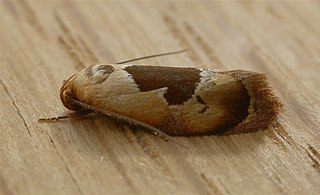Related Research Articles

Hoplomorpha camelaea is a moth in the family Oecophoridae first described by Edward Meyrick in 1888. It is found in Australia, where it has been recorded from Victoria, Queensland, New South Wales and the Australian Capital Territory.
Brenthia pleiadopa is a species of moth of the family Choreutidae first described by Edward Meyrick in 1921. It is found in Magude, Mozambique.
Helcystogramma lithostrotum is a moth in the family Gelechiidae. It was described by Edward Meyrick in 1916. It is known from Malaysia.
Charistica ioploca is a moth in the family Gelechiidae. It was described by Edward Meyrick in 1922. It is found in Amazonas, Brazil.
Chlamydastis praenubila is a moth of the family Depressariidae. It is found in Brazil.
Antaeotricha modulata is a species of moth of the family Depressariidae. It is found in Brazil, Guyana and French Guiana.
Cerconota rosacea is a moth of the family Depressariidae. It is found in the Amazon region and French Guiana.
Torodora fortis is a moth in the family Lecithoceridae. It was described by Edward Meyrick in 1918. It is found in southern India.
Thubana bullulata is a moth in the family Lecithoceridae. It was described by Edward Meyrick in 1923. It is found in India (Assam).
Torodora oxalea is a moth in the family Lecithoceridae. It was described by Edward Meyrick in 1910. It is found in southern India.
Deltoplastis scopulosa is a moth in the family Lecithoceridae. It was described by Edward Meyrick in 1910. It is found in southern India.
Torodora deltospila is a moth in the family Lecithoceridae. It was described by Edward Meyrick in 1911. It is found in India in Assam, Himachal Pradesh, Dehradun and Jammu and Kashmir.
Comotechna dentifera is a moth in the family Depressariidae. It was described by Edward Meyrick in 1921. It is found in Brazil and Peru.
Comotechna parmifera is a moth in the family Depressariidae. It was described by Edward Meyrick in 1921. It is found in Peru and Pará, Brazil.
Comotechna scutulata is a moth in the family Depressariidae. It was described by Edward Meyrick in 1921. It is found in Brazil.
Comotechna semiberbis is a moth in the family Depressariidae. It was described by Edward Meyrick in 1921. It is found in Peru.
Antaeotricha nitescens is a species of moth in the family Depressariidae. It was described by Edward Meyrick in 1925. It is found in Brazil (Para).
Chlamydastis epophrysta is a moth in the family Depressariidae. It was described by Edward Meyrick in 1909. It is found in Peru.
Moca aphrodora is a species of moth in the family Immidae first described by Edward Meyrick in 1922. It is found in Brazil and Peru.
Imma eriospila is a species of moth in the family Immidae. It was described by Edward Meyrick in 1922. It is found in Pará, Brazil.
References
- ↑ Markku Savela. "Torodora Meyrick, 1894". Lepidoptera and Some Other Life Forms. Retrieved 3 January 2016.
- ↑ Journal of the Bombay Natural History Society 20 (2): 443
| This article relating to the genus Torodora is a stub. You can help Wikipedia by expanding it. |